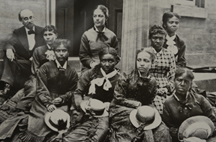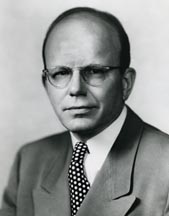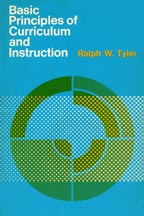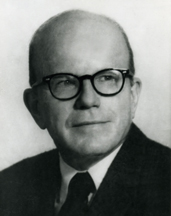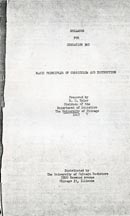| |
|
|
| |
Books of the 20th Century Exhibition
An introduction to some publications that have shaped the field of education. |
|
|
|
|
| |
|
|
Basic Principles
of Curriculum and Instruction
by Ralph W. Tyler (1902–1994) Chicago: University of Chicago, 1949.
|
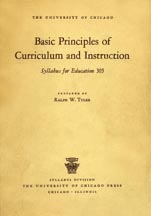
|
|
|
|
| |
|
|
|
“If any single volume deserves to be called the Bible of curriculum making it is certainly Ralph Tyler’s Basic Principles of Curriculum and Instruction . . . . It has gone through dozens of printings and several translations since then and is still widely sold. A more influential text within the field of curriculum would be hard to name.”
––Philip W. Jackson, “Conceptions of curriculum and curriculum specialists,” in Handbook of Research on Curriculum, edited by P. W. Jackson, 1992, p. 24. |
|
|
|
|
|
|
| |
While Ralph W. Tyler has been called the “dean of American education of the 20th century,” few books have caused such extreme reactions in the fields of curriculum studies and curriculum development as his 1949 Education 360 syllabus, Basic Principles of Curriculum and Instruction. Tyler’s “little book” is criticized and applauded with great fervor. The same can be said of the author who has been accused of plagiarism by one contemporary curriculum theorist, cursed by many others, while also being described by contemporary policy makers as one of the most important educators of the 20th century.
During Tyler’s career, he served as Dean of Social Sciences at the University of Chicago, director of the Center for Advanced Study in the Behavioral Sciences at Stanford, CA, official and unofficial advisor to many presidents of the United States, and chairperson of the committee that would develop NAEP (National Assessment of Educational Progress).
|
|
|
|
|
|
Basic Principles became a primer during the later 20th century for the development of resource units, core curriculum, continuity, sequence, and curricular integration. The Tyler Rationale “. . . developed in this syllabus begins with identifying four fundamental questions which must be answered in developing any curriculum and plan of instruction. These are: What educational purposes should the school seek to attain? What educational experiences can be provided that are likely to attain these purposes? How can they be organized? How can we determine whether these purposes are being attained? This syllabus suggests methods for studying these questions. No attempt is made to answer these questions since the answers will vary to some extent from one level of education to another and from one school to another.”
––Ralph W. Tyler, Basic Principles of Curriculum and Instruction, 1949, pp. 1-2 |
|
|
|
|
Tyler began teaching Education 360 at the University of Chicago in the late 1930s while enmeshed in the work of the Progressive Education Association and the American Council on Education––namely the Eight Year Study and the Cooperative (higher education) Study in General Education (perhaps accounting for the final chapter of Basic Principles of Curriculum and Instruction being devoted to school and college staffs).
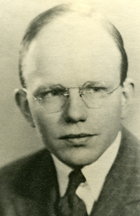
Tyler lore describes a lunch occasion in the 1930s when “Mike” Giles, Hilda Taba, and Tyler were discussing curriculum development and the 1949 Rationale’s legendary questions were conceived by Tyler and written on a napkin: What educational purposes should the school seek to attain? What educational experiences can be provided that are likely to attain these purposes? How can they be organized? How can we determine whether these purposes are being attained? During this same period, Giles and the Aikin Commission’s Curriculum Associates were charged with formulating “a set of basic principles for the secondary school curriculum,” questions important enough to appear on the first page of their 1942 report, Exploring the Curriculum. These included: What is to be done? What subject matter is to be used? What classroom procedures and school organization are to be followed? How are the results of the program to be appraised? and display great similarity with the intent of the Tyler Rationale. (H. H. Giles, S. P. McCutchen, and A. N. Zechiel, 1942, Exploring the Curriculum, 1942, p. 1.)
Both frameworks stressed the use of educational objectives, although neither represents the use of behavioral objectives as we interpret the term today. Tyler’s call to “formulate objectives” required educators to reconsider their most fundamental educational goals and, when situated within the context of a situational problem, became a way to reestablish “intentions” (which perhaps would have been a better term to have used). Objectives did not represent the confining, convergent dimension that was later popularized in the 1960s and 1970s with behavioral objectives and Management by Objectives programs. In fact, the Curriculum Associates describe the genesis of educational objectives in relation to the central purposes of education. For Tyler, behaviors meant all types of human reactions at all levels of cognition. Throughout the Eight Year Study, objectives were developed for non-observable behaviors: social sensitivity, appreciation, personal and social adjustment.
Contemporary curricularists object ad nauseam to the lock-step, linear aspect of the Tyler Rationale. In fact, Tyler seem to anticipate this concern and stated the following: “A question arising in the attempt at curriculum revision by a school or part of a school is whether the sequence of steps to be followed should be the same as the order of presentation in this syllabus. The answer is clearly ‘No.’ The concern of the staff, the problems already identified, the available data are all facts to consider in deciding on the initial point of attack.”
––Ralph W. Tyler, Basic Principles of Curriculum and Instruction, 1949, p. 83.
Opening Lines
“This course, Education 360––Basic Principles of Curriculum and Instruction is provided in the offerings of the Department of Education as an overview of the field of curriculum and instruction. The course does not attempt to give the student a comprehensive picture of curriculum trends, that is, the new developments in programs of instruction, nor does it seek to develop the skills involved in planning and conducting an instructional program. Rather, the purpose is to help the student of education to understand more fully the kinds of problems involved in developing a curriculum and plan of instruction and to acquire some techniques by which these basic problems may be attacked” (p. 1).
|
|
|
|
|
|
|
|
|
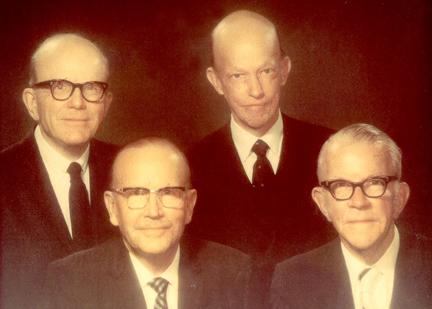
The Tyler Brothers, l-r:
Ralph W. Tyler (1902-1994), Harry Tyler (1898-1982),
I. Keith Tyler (1905-1994), Tracy F. Tyler (1895-1985)
One problem with Basic Principles of Curriculum and Instruction is that it turned from “being read” to “becoming myth.” Since Tyler’s syllabus was published during the “behavioral binge” of the 1950s, 1960s, and 1970s, his use of the word “behavior” was often translated by others into an endorsement of behavioral objectives and behaviorism. The syllabus’ meaning and intent shifted quite dramatically leading to him being identified, erroneously, as the “father of behavioral objectives.” Yet, Tyler stated that behavior was not limited to overt behavior, and what a student felt or thought was included as sources for curriculum development. “Human capabilities” became Tyler’s phrase of choice when discussing behavior, and he disagreed with the unfortunate outcomes of behavioral objectives when education was reduced to mere training. Two separate 1973 interviews—“The Father of Behavioral Objectives Criticizes Them” and “Ralph Tyler Discusses Behavioral Objectives”—clearly make this point, including his belief that behavioral objectives had become too specific.
“Tyler had a genius for inventing what appeared to be highly plausible and simple solutions to very complex problems. Indeed, his entire impact on American education has been through this capacity . . . . . . . . Of course, there are no simple solutions to the complex problems of education, but those who believe they have invented them do manage to exert influence.” Robert M. W. Travers, How Research Has Changed American Schools, 1983
Much can be said of Tyler’s ability to clarify procedures and to state ideas in simple ways. Perhaps due to its clarity, his work has been widely applied but also often misinterpreted, most notably with his use of educational objectives but also with the Tyler Rationale, Basic Principles of Curriculum and Instruction, probably the most influential curriculum book of the 20th century. Often viewed as a direct, value-free curriculum development process, the Rationale has received its share of criticism for embodying questionable values. In a little known 1970 interview after the release of “The Tyler Rationale: A Reappraisal” by Herbert Kliebard, the strongest criticism brought against the work, Tyler maintained that he never sought to develop a curriculum theory or “theoretical formulation of what a curriculum should be” but merely wished to pose an outline of kinds of questions that should be asked. Answers to these questions were the responsibility of others, not Tyler. |
|
|

Historic audio footage of Ralph W. Tyler
responding to Kliebard's critique of The Tyler Rationale
|
|
|

Historic video footage of Ralph W. Tyler
from the 1976 Milwaukee Curriculum Theory Conference
forthcoming
|
|
|
Quotes
“Probably no thoughtful proponent of progressive education ever advocated teaching students only the things in which they were at that moment interested, but the argument for using studies of student interests as a basis for objectives runs somewhat as follows: Education is an active process. It involves the active efforts to the learner himself. . . . Hence, it is essential to see that education provides opportunities for the student to enter actively into, and to deal wholeheartedly with, the things which interest him, and in which he is deeply involved, and to learn particularly how to carry on such activities effectively.
“There are many educators who do not consider attention to the present interests of students as an adequate educational program because one of the functions of education is to broaden and deepen the student’s interest so that he will continue his education long after he has ended his formal school training. But even these educators recognize the value of beginning with present student interests as a point of departure. Hence, various groups conduct investigations of student interests to throw light upon the possible educational objectives of the school. Where these interests are desirable ones they provide the starting point for effective instruction. Where the interests are undesirable, narrow, limited or inadequate, they indicate gaps which need to be overcome if the student is to receive an effective education” (p. 8).
“It is not only necessary to recognize that learning experiences need to be organized to achieve continuity, sequence, and integration, and that major elements must be identified to serve as organizing threads for these learning experiences, it is also essential to identify the organizing principles by which these threads shall be woven together. . . . Organizing principles are needed that can serve as a basis for planning the respects in which the broadening and the deepening of major curriculum elements in the program will take place.
“In identifying important organizing principles, it is necessary to note that the criteria, continuity, sequence, and integration apply to the experiences of the learner and not to the way in which these matters may be viewed by someone already in command of the elements to be learned. Thus, continuity involves the recurring emphasis in the learner’s experience upon these particular elements; sequence refers to the increasing breadth and depth of the learner’s development; and integration refers to the learner’s increased unity of behavior in relating to the elements involved. This means that the organizing principles need to be considered in terms of their psychological significance to the learner” (pp. 62-63).
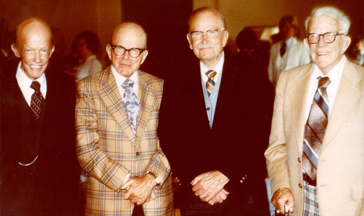
The Tyler Brothers, l-r: I. Keith Tyler was a professor of educational radio at Ohio State University; Ralph W. Tyler; Harry Tyler was a school superintendent in Santa Barbara county; Tracy F. Tyler was a professor of education and administrator at Univerity of Minnesota
Closing Lines
“Another question arising in the attempt at curriculum revision by a school or part of a school is whether the sequence of steps to be followed should be the same as the order of presentation in this syllabus. The answer is clearly ‘No.’ The concern of the staff, the problems already identified, the available data are all factors to consider in deciding on the initial point of attack. In one school, participation by the staff in a program of child study may provide an entering wedge in studying the learner, in another school the results of a follow-up of graduates may focus attention upon identifiable inadequacies in the present program which will lead easily to systematic study. In another situation, the deliberations over a school philosophy may provide an initial step to an improvement of objectives, and then to a study of the learning experiences. The purpose of the rationale is to give a view of the elements that are involved in a program of instruction and their necessary interrelations” (p. 83).
Contents
Basic Principles of Curriculum and Instruction: Syllabus for Education 360 by Ralph Winfred Tyler (1902–1994; University of Chicago). Chicago: University of Chicago Press, 1949. [83 p.; 23 cm.]
Introduction p. 1
What Educational Purposes Should the School Seek to Attain? p. 3
How Can Learning Experiences be Selected Which are Likely to be Useful in Attaining These Objectives? p. 41
How Can Learning Experience be Organized for Effective Instruction? p. 54
How Can the Effectiveness of Learning Experiences be Evaluated? p. 68
How a School or College Staff May Work on Curriculum Building? p. 82
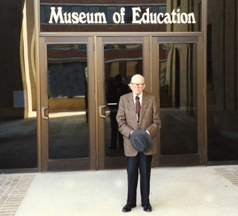
In 1959, Martin Dworkin stated that “John Dewey is a figure of partisan fiction. Extreme disavowals of his importance are countered by passionate assertions of his greatness. The images of Dewey created in this kind of clamor may say a great deal about American attitudes.” The same certainly can now be said of Ralph Tyler and of Basic Principles of Curriculum and Instruction.
Bibliography
Giles, H. H., S. P. McCutchen and A. N. Zechiel. (1942). Exploring the Curriculum. New York: Harper & Brothers.
Jackson, P. W. (1992). “Conceptions of Curriculum and Curriculum Specialists,”in Handbook of Research on Curriculum, edited by P. W. Jackson. New York: Macmillan Co., pp. 3-40.
Travers, R. M. W. (1983). How Research Has Changed American Schools. Kalamazoo, MI: Mythos Press.
to return to the Books of the 20th Century Exhibition |
|
|
|
|
|
|
|
|
|
|
|
|
|
|
|
|
|
|
|
|
|
|
|
|
